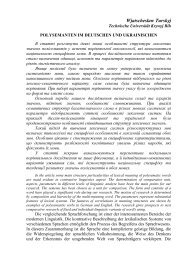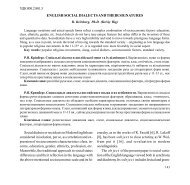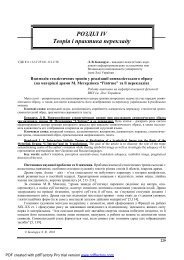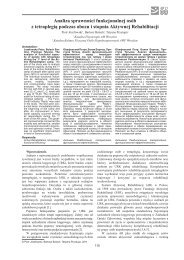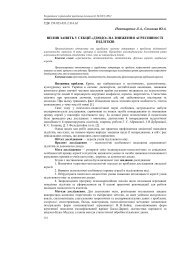Disappearance of aligning properties of deposited SiOx films as ...
Disappearance of aligning properties of deposited SiOx films as ...
Disappearance of aligning properties of deposited SiOx films as ...
Create successful ePaper yourself
Turn your PDF publications into a flip-book with our unique Google optimized e-Paper software.
Semiconductor Physics, Quantum Electronics & Optoelectronics, 2006. V. 9, N 3. P. 60-65.<br />
structure were divided into three parts. First part w<strong>as</strong><br />
stored in a closed volume (drying bottle with silica gel),<br />
the second one w<strong>as</strong> stored under the room conditions<br />
(temperature w<strong>as</strong> 20…25 ºC and humidity 50…70 %),<br />
and third one – at the room temperature in a closed<br />
volume with saturated water vapor (distilled water).<br />
After that, every day one substrate from these three parts<br />
w<strong>as</strong> <strong>as</strong>sembled with the <strong>as</strong>-prepared test substrate and<br />
filled with NLC. After <strong>aligning</strong>, the obtained NLC structures<br />
were investigated using a polarization microscope.<br />
The images <strong>of</strong> the typical defects <strong>of</strong> TN LC structures<br />
were recorded. The quality <strong>of</strong> TN LC structures obtained<br />
by two test <strong>of</strong> the <strong>as</strong>-prepared and <strong>as</strong>sembled substrates<br />
w<strong>as</strong> high, and defects or imperfections were absent.<br />
To study the defects after thermal treatment <strong>of</strong> <strong>SiOx</strong><br />
<strong>aligning</strong> layers, four types <strong>of</strong> substrates were used. The<br />
first type w<strong>as</strong> made <strong>of</strong> K8 gl<strong>as</strong>s, the second one – silica,<br />
the third and fourth ones were made <strong>of</strong> gl<strong>as</strong>s and had the<br />
ITO electrodes (substrates for watch displays) opened<br />
and covered by SiO2, respectively. Deposition <strong>of</strong> <strong>SiOx</strong><br />
<strong>aligning</strong> layer w<strong>as</strong> carried out by the CRS method <strong>as</strong><br />
described in [10-13]. The parameters <strong>of</strong> the technological<br />
process were <strong>as</strong> follows: the applied cathode<br />
voltage U (from 2.5 up to 5 kV), current density J (from<br />
1 to 5 mA/cm 2 ), oxygen concentration kO (50 %). To<br />
study the preferable storage conditions <strong>of</strong> the prepared<br />
substrates with <strong>aligning</strong> layer, used were the substrates<br />
<strong>of</strong> the third and fourth types. The <strong>SiOx</strong> <strong>aligning</strong> layer<br />
w<strong>as</strong> on these substrates with the same parameters. In the<br />
course <strong>of</strong> deposition, three various values <strong>of</strong> oxygen<br />
concentrations kO (0, 50 or 100 %) were used.<br />
3. Results and discussion<br />
3.1. Defects <strong>of</strong> alignment after the heat treatment<br />
Our analysis showed that defects <strong>of</strong> alignment after the<br />
heat treatment differ and can be divided into four kinds<br />
according to the influence <strong>of</strong> the following factors:<br />
a) the heat treatment;<br />
b) substrate <strong>properties</strong>;<br />
c) evaporation <strong>of</strong> gl<strong>as</strong>s frit decomposition products;<br />
d) low temperature glue decomposition (tapes <strong>of</strong><br />
PVB, BF and others).<br />
a) b) c)<br />
Fig. 1. Defects <strong>of</strong> <strong>aligning</strong> at various annealing temperatures: 460 (a), 480 (b), and 500 ºC (c).<br />
© 2006, V. L<strong>as</strong>hkaryov Institute <strong>of</strong> Semiconductor Physics, National Academy <strong>of</strong> Sciences <strong>of</strong> Ukraine<br />
61<br />
At the annealing temperature in the range <strong>of</strong> 400 to<br />
520 ºC, <strong>aligning</strong> layers on silica, K8 gl<strong>as</strong>s and SiO2covered<br />
ITO electrodes (fourth type <strong>of</strong> substrates)<br />
created defectless high quality TN LC structures. It<br />
means that the <strong>SiOx</strong> <strong>aligning</strong> layer remains thermally<br />
stable up to 520 ºC for the enough wide ranges <strong>of</strong><br />
deposition technological parameters.<br />
Imperfect TN LC structures were obtained on the<br />
substrates <strong>of</strong> the third type (gl<strong>as</strong>s with opened ITO<br />
electrodes) when the annealing temperature w<strong>as</strong> higher<br />
than 450 ºC. These structures had a lot <strong>of</strong> defects such <strong>as</strong><br />
disclination lines surrounded by the squares <strong>of</strong> 0.1 to<br />
1 mm 2 located on the substrate surface in the area free <strong>of</strong><br />
ITO electrodes. The photos <strong>of</strong> these defects are shown in<br />
Fig. 1.<br />
However, the TN LC structures between ITO<br />
electrodes w<strong>as</strong> perfect after annealing <strong>of</strong> the substrates<br />
up to the temperature 515 ºC.<br />
The re<strong>as</strong>on <strong>of</strong> defect appearance on gl<strong>as</strong>s surface is<br />
the processes <strong>of</strong> gl<strong>as</strong>s lixiviation causing chemical<br />
interaction (for example, free sodium) with the <strong>deposited</strong><br />
<strong>SiOx</strong> film or mechanical destruction <strong>of</strong> <strong>aligning</strong> layer<br />
under the action <strong>of</strong> high annealing temperature. As w<strong>as</strong><br />
experimentally shown, the temperature <strong>of</strong> such defect<br />
appearance is in the range from 440 to 480 ºC and even<br />
sometimes up to 500 ºC and depending on the type <strong>of</strong><br />
gl<strong>as</strong>s substrates.<br />
As shown in Fig. 2, with incre<strong>as</strong>ing the cathode<br />
voltage the temperature <strong>of</strong> defect appearance w<strong>as</strong><br />
incre<strong>as</strong>ing, too. The re<strong>as</strong>on <strong>of</strong> such behavior is the<br />
higher temperature <strong>of</strong> ion treatment <strong>of</strong> substrate in the<br />
deposition process because <strong>of</strong> the greater ion energy.<br />
3.2. Defects related to the influence <strong>of</strong> gl<strong>as</strong>s frit<br />
Defects caused by the influence <strong>of</strong> evaporation <strong>of</strong> gl<strong>as</strong>s<br />
frit decomposition product on <strong>aligning</strong> layers at heat<br />
treatment have a sufficient difference in comparison<br />
with the considered above. In this c<strong>as</strong>e, the destruction<br />
<strong>of</strong> <strong>aligning</strong> layers w<strong>as</strong> observed on the surface <strong>of</strong> ITO<br />
electrodes. The photo <strong>of</strong> these defects is shown in Fig. 3.<br />
It w<strong>as</strong> noticed that defects appeared, when the annealing<br />
temperature w<strong>as</strong> by 20 to 40 ºC higher than that <strong>of</strong> gl<strong>as</strong>s



